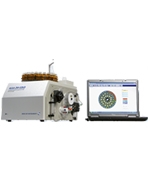|
##Fully automated flow analysis system
##Proven and reliable detection method: cold vapor atomic absorption (CVAAS)
##Integrated GoldTrap for a maximum of sensitivity of <1 ng/l
##Easy to operate with AULAWIN software
##Automated Sample Digester Module (ASD) for liquid samples as an optional accessory
Applications
The AULA 254 is used for fully automatic determination of mercury traces in liquid samples and sample digests. The instrument carries out routine analysis: sample after sample following exactly the preselected procedure thus increasing efficiency and productivity of your lab. Applications include:
##Water, waste water, soils and Effluents
##Applicable to EPA Methods: 245.1, 245.7, 1631, 7470 and 7471A
##Medicine (urine, blood, saliva, hair)
##Chemical industry (process monitoring, quality control)
##Geochemistry (geological and mineralogical samples)
##Petrochemistry
##Metallurgy and material testing
Reliable and proven method
The working principle of the system is based on the continuous flow method. First the mercury contained in the sample is transformed into the elemental state by addition of a reducing agent to the sample flow. In a cross-flow reactor the mercury is stripped with a gas stream and carried into the optical cell which is made entirely of fused silica. There the quantitative determination of mercury is obtained by measuring UV absorption at a wavelength of 253,7 nm at room temperature. This analytical technique is commonly known as cold vapor atomic absorption spectrometry (CVAAS), a method that has proved itself as extremely sensitive and selective over many years.

Optimized mercury detection technique
In contrast to a typical multi-element AAS the AULA is specially designed for mercury determination. This allows top performance in analytical applications. The use of a highly stable low-pressure electrodeless mercury discharge lamp (EDL) in connection with the latest UV detector techniques result in excellent baseline stability and low detection limits.
AULAWIN software
Surprisingly easy to use the AULA-WIN offers all features of a modern analytical software. It has been developed with extensive input from our users. Samples, calibration standards and quality control standards (QCS) are entered into the carrousel screen. With an optional barcode stick sample data can be entered comfortably. A sample table is created automatically and can be viewed in the table screen. Sample dilution factors as well as sample weight and final fill up volume for digestion of solid samples can be entered in the table. The result of the measurement is calculated automatically from the chosen calibration function and displayed in µg/l or µg/kg. The QCS function assures a high level of reliability of the analytical results. The results of the analyses together with the data necessary for quality assurance (date, time, user ID, sample number, calibration data, instrument parameters) are stored in a file. They are available at any time for display and printout. Worksheet templates can be created and stored to minimize setup time for routine work.

High productivity
No long purging or rinsing procedures even when samples with high concentrations are analyzed. The typical duration of a full measurement cycle is 80 ... 280 seconds. The quick screening mode allows performing analyses in even a shorter time
How measurement is performed
Measurements of up to 20 calibration standards and up to 53 samples and check standards are carried out fully automatically. Standards and samples are filled into 10 ml glass vials and positioned on the auto-sampler turntable. Reagent solution (for example tin-(II)-chloride) and rinse solution (reagent water) are filled in the corresponding glass tanks. Then the stripping gas flow is adjusted and measurement is started by a keystroke. Mercury Instruments Figure: AULA-254 Gold reaction part The measurement cycle can be interrupted at any time by the operator for selecting any sample to be measured next. Readings and instrument status are displayed in real-time on the screen. The stability of the baseline is checked prior to each measurement and the zero point is adjusted automatically. The typical zero drift during a measurement is below 0.0001 absorbance units.

Minimized memory effects
Mercury vapor has a general tendency to absorb on surfaces causing a memory effect. This undesirable property has been minimized by using selected materials (fluoropolymer, borosilicate glass, Tygon LFL) for sample and reagent conducting components and by heating the optical bench. In addition, the auto-sampler probe and the sample tubing are rinsed after each sample. This also allows a high sample throughput. Even samples with concentrations in the upper measuring range do not produce a carry over to the following sample.
Thermoelectric dehumidifier
Unlike traditional mercury analyzers, which use drying tubes for removing water vapor from the sample gas, the AULA 254 uses a maintenance-free thermoelectric dehumidifier. The dew point of the gas is decreased below ambient temperature thus the water condenses on the wall of a small glass tube and flows back into the reactor.
Carrier gas flow stabilization with MFC
The stability of the carrier gas flow has a direct effect to the reproducibility of measurements. For this reason the AULA-254 Gold system uses a highly precise (1.5 % accuracy) electronic mass flow controller (MFC).
Safety for the user
The instrument automatically interrupts the measurement if samples with mercury concentrations exceeding the measuring range are detected. In this case the system is immediately cleaned.
Automated sample digestion module (ASD)
The AULA 254 can be equipped with an optional sample preparation system for aqueous samples. The digestion procedure derives from standard methods commonly used in the laboratory. The sample is automatically drawn from the auto-sampler vial and is continuously mixed with a strong oxidizing reagent (e.g. potassium permanganate, bromide-bromate). Subsequently the sample/oxidant mixture is heated to approx. 98 °C in a heated coil. After the oxidation step hydroxylamine hydrochloride and tin-(II)-chloride are added for reduction of mercury into the elemental state.

Comparison of microwave digested samples (light blue) and directly with AULA-ASD measured samples (red) Sample
A: seepage water from chlor-alkali plant Sample
B: tank rinsing water from chlor-alkali plant Sample
C: effluents from PTFE production plant Sample
D: sewer plant effluent
The AULA-ASD is economical.
Average reagent consumption for 100 analyses is:
##10 g hydroxylamine hydrochloride
##1-5 g potassium permanganate
##20 g tin-(II)-chloride
##5 l water (deionized)
|











